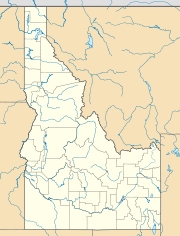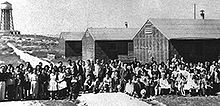- Minidoka National Historic Site
-
Minidoka National Historic Site IUCN Category V (Protected Landscape/Seascape)Location Jerome County, ID, USA Nearest city Eden, Idaho Coordinates 42°38′13″N 114°13′56″W / 42.63694°N 114.23222°WCoordinates: 42°38′13″N 114°13′56″W / 42.63694°N 114.23222°W Area 292 acres (118 ha)[1] Authorized January 17, 2001 Governing body National Park Service Minidoka National Historic Site is a National Historic Site that commemorates the Minidoka War Relocation Center of the Second World War. It is located in Jerome County, Idaho, 17 miles (27 km) northeast of Twin Falls and just north of Eden, in an area known as Hunt, in the remote high desert area north of the Snake River. The site is administered by the National Park Service of the U.S. Department of the Interior.
Contents
The Minidoka War Relocation Center
 Minidoka Relocation Center, watch repair shop. Sokichi Hoshide, head watch-maker
Minidoka Relocation Center, watch repair shop. Sokichi Hoshide, head watch-maker
The Minidoka War Relocation Center was in operation from 1942–45 and one of ten camps at which Japanese Americans, both citizens and resident aliens, were interned during World War II.Under provisions of President Roosevelt's Executive Order 9066, all persons of Japanese ancestry were excluded from the West Coast of the United States. Minidoka housed more than 9,000 Japanese Americans, predominantly from Oregon, Washington, and Alaska.[2]
The Minidoka irrigation project shares its name with Minidoka County. The Minidoka name was applied to the Idaho relocation center in Jerome County to avoid confusion with the Jerome War Relocation Center in Jerome, Arkansas.[citation needed] Construction by the Morrison-Knudsen Company began in 1942 on the camp, which received 10,000 internees by years' end. Many of the internees worked on the irrigation project or as farm labor. Population declined to 8500 at the end of 1943, and to 6950 by the end of 1944. On February 10, 1946 the now-vacant camp was turned over to the U.S. Bureau of Reclamation, which used the facilities to house returning war veterans.[3]
National Historic Site
The internment camp site was listed on the National Register of Historic Places on July 10, 1979. The site was established in 2001, and as one of the newest units of the National Park System, it does not yet have any visitor facilities or services available on location. However, a temporary exhibit and information about the monument is on display at the visitor center of the nearby Hagerman Fossil Beds National Monument. Currently, visitors see the remains of the entry guard station, waiting room, and rock garden and can visit the Relocation Center display at the Jerome County Museum in nearby Jerome and the restored barracks building at the Idaho Farm and Ranch Museum southeast of town. There is a small marker adjacent to the remains of the guard station, and a larger sign at the intersection of Highway 25 and Hunt Road, which gives some of the history of the camp.
The National Park Service began a three-year public planning process in the fall of 2002 to develop a General Management Plan (GMP) and Environmental Impact Statement (EIS).[citation needed] The General Management Plan sets forth the basic management philosophy for the Monument and provides the strategies for addressing issues and achieving identified management objectives that will guide management of the site for the next 15–20 years.[citation needed]
On December 21, 2006, President Bush signed H.R. 1492 into law guaranteeing $38,000,000 in federal money to restore the Minidoka relocation center along with nine other former Japanese internment camps.[4]
On May 8, 2008, President George W. Bush signed the Wild Sky Wilderness Act into law, which changed the status of the former U.S. National Monument to National Historic Site and added the Nidoto Nai Yoni (Let It Not Happen Again) Memorial on Bainbridge Island, Washington to the monument.[5][6]
Notable Minidoka internees
- Paul Chihara (born 1938), an American composer.
- Ken Eto (1919–2004), a Japanese-American mobster with the Chicago Outfit and eventually an FBI informant
- Fujitaro Kubota (1879–1973), an American gardener and philanthropist.
- Shig Murao (1926–1999), a San Francisco clerk who played a prominent role in the San Francisco Beat scene.
- William K. Nakamura (1922–1944), a United States Army soldier and a recipient of the Medal of Honor.
- George Nakashima (1905–1990), a Japanese American woodworker, architect, and furniture maker.
- John Okada (1923–1971), a Japanese American writer.
- Roger Shimomura (born 1939), an American artist and a retired professor.
- Monica Sone (1919–2011), a Japanese American novelist.
- Gary A. Tanaka (born 1943), a Japanese-American businessman.
- Newton K. Wesley (1917–2011), an optometrist and an early pioneer of the contact lens[7]
- Mitsuye Yamada (born 1923), a Japanese American writer.
- Takuji Yamashita (1874–1959), an early 20th century civil rights pioneer. Also interned at Tule Lake and Manzanar.
- Minoru Yasui (1916–1986), a Japanese American lawyer who challenged the constitutionality of curfews used during World War II in Yasui v. United States.
- Chiaki Yoshihara (born 1921), college football player. He helped lead the 1941 Oregon State Beavers to the 1942 Rose Bowl but was unable to travel to the game because it was more than 35 miles away.[8][9]
See also
- Manzanar National Historic Site
- War Relocation Authority
- Paintings of Minidoka[10] by Ed Tsutakawa
References
- ^ "Minidoka National Historic Site". The National Parks: Index 2009–2011. 2011-07-04. http://www.nps.gov/history/history/online_books/nps/nps/part2.htm#miin.
- ^ "Friends of Minidoka: WWII Internment". http://www.minidoka.org/ww2internment.htm. Retrieved 2008-05-15.
- ^ Stene, Eric A. (1997). "The Minidoka Project". U.S. Bureau of Reclamation. http://www.usbr.gov/projects//ImageServer?imgName=Doc_1245093434100.pdf.
- ^ "H.R. 1492". georgewbush-whitehouse.archives.gov. http://georgewbush-whitehouse.archives.gov/news/releases/2006/12/20061221-2.html.
- ^ Pacific Citizen Staff, Associated Press (2008-05-16). "Bush Signs Bill Expanding Borders of Minidoka Monument". Japanese American Citizens League. http://pacificcitizen.org/content/2008/national/may16-pcstaff-minidoka-monument-1048.htm. Retrieved 2008-06-18.[dead link]
- ^ Stahl, Greg (2008-05-14). "Congress Expands Minidoka Site". Idaho Mountain Express. http://www.mtexpress.com/index2.php?ID=2005120668. Retrieved 2008-06-18.
- ^ "Newton K. Wesley: 1917-2011 Eye care pioneer helped evolve contact lenses". Chicago Tribune. 25 July 2011. http://www.chicagotribune.com/news/local/ct-met-obit-wesley-20110725,0,6376556.story. Retrieved 25 July 2011.
- ^ Odegard, Kyle (2008-06-16). "Former students get degrees at last". Albany Democrat-Herald. http://www.dhonline.com/articles/2008/06/22/news/local/7loc02_grad.txt. Retrieved 2008-08-17.
- ^ Foster, Chris (2008-11-22). "War And The Roses For Oregon State". Los Angeles Times. http://www.latimes.com/sports/printedition/la-sp-beavers22-2008nov22,0,1014340,full.story. Retrieved 2008-11-23.
- ^ http://spokane-nishinomiyasistercitysociety.org/tsutakawa/index.html
External links
- Official Park Service site
- Minidoka Relocation Center historical photographs at the University of Washington Libraries Digital Collections
Japanese American World War II War Concentration Camps U.S. National Register of Historic Places Topics Lists by states Alabama • Alaska • Arizona • Arkansas • California • Colorado • Connecticut • Delaware • Florida • Georgia • Hawaii • Idaho • Illinois • Indiana • Iowa • Kansas • Kentucky • Louisiana • Maine • Maryland • Massachusetts • Michigan • Minnesota • Mississippi • Missouri • Montana • Nebraska • Nevada • New Hampshire • New Jersey • New Mexico • New York • North Carolina • North Dakota • Ohio • Oklahoma • Oregon • Pennsylvania • Rhode Island • South Carolina • South Dakota • Tennessee • Texas • Utah • Vermont • Virginia • Washington • West Virginia • Wisconsin • WyomingLists by territories Lists by associated states Other Federal National ParksMinidoka National Historic SiteNational MonumentsNational ForestsBitterroot • Boise • Caribou-Targhee • Clearwater • Coeur d'Alene • Idaho Panhandle • Kaniksu • Kootenai • Nez Perce • Payette • Salmon-Challis • Sawtooth • St. Joe • Wallowa–Whitman • Wasatch-CacheNational Wildlife RefugesBear Lake • Camas • Deer Flat • Grays Lake • Kootenai • Minidoka • Oxford Slough Waterfowl Production AreaBig Jacks Creek • Bruneau-Jarbidge Rivers • Craters of the Moon • Frank Church-River of No Return • Gospel Hump • Hells Canyon • Little Jacks Creek • North Fork Owyhee • Owyhee River • Pole Creek • Selway-Bitterroot • SawtoothState Bear Lake • Bruneau Dunes • Castle Rocks • City of Rocks • Coeur d'Alene Parkway • Dworshak • Eagle Island • Farragut • Harriman • Hells Gate • Henrys Lake • Heyburn • Lake Cascade • Lake Walcott • Land of the Yankee Fork • Lucky Peak • Massacre Rocks • McCroskey • Old Mission • Ponderosa • Priest Lake • Round Lake • Thousand Springs • Three Island Crossing • Trail of the Coeur d'Alenes • Winchester Lake •Idaho Department of Parks & Recreation (website)Categories:- IUCN Category V
- Protected areas established in 2001
- Japanese-American internment camps
- Protected areas of Jerome County, Idaho
- National Historic Sites in Idaho
- Buildings and structures in Jerome County, Idaho
Wikimedia Foundation. 2010.


